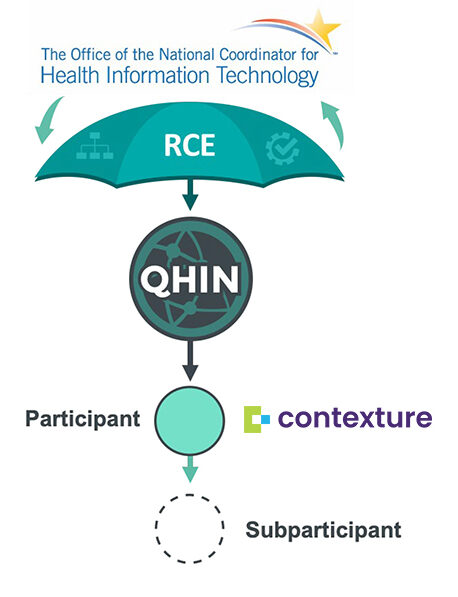Background
Contexture, as a health information exchange (HIE), serves a critical role in the overall ecosystem of data exchange and electronic health record (EHR) connectivity. HIEs were born as EHRs became mainstream and connectivity between and among them became critical to patient care. While most HIEs connect to EHRs, there are also connections to state systems and registries, national reporting databases, etc.
However, HIEs aren’t the only entities that operate in the data exchange market. There are also several national frameworks and networks in place that work in parallel, and/or, at times, partnership with HIEs. Understanding the ways that the various national networks operate and intersect with Contexture is helpful in terms of our current and future strategies.
In addition to networks, there are also important frameworks, such as the Trusted Exchange Framework and Common Agreement (TEFCA) that also impact and guide the way HIEs and national networks interact and interoperate.
TEFCA is a technical and legal framework for supporting nationwide health information exchange. TEFCA isn’t an organization or legal entity. It isn’t a health information exchange or network. It’s a series of legal agreements that establish the “rules of the road” and minimum technical requirements for organizations that decide they want to exchange health data with other participants in the TEFCA ecosystem.
For additional information on TEFCA, especially how it relates to the eHealth Exchange, click here.
What makes Contexture, as an HIE, different from the national networks and national frameworks?
Contexture, like many other HIEs, offers additional value (beyond the national networks) in many ways.
- A foundational component of successful HIEs is centered around robust identity management processes and data normalization efforts. Unlike networks like eHealth Exchange that just receive and transmit data, Contexture helps identify, manage, normalize and apply higher levels of data quality standards to the data. This makes the downstream utilization significantly more valuable.
- In addition, Contexture doesn’t only respond to data upon request or query, we push the data into the workflows and systems used by our participants. This is fundamentally different — to access eHX or Carequality data, a user must initiate an ask for data. When leveraging the Contexture HIE, the data is automatically routed to the systems (if the participant is using Notifications/Alerts) without any action.
- Contexture is EHR agnostic and connects to hundreds of EHR systems. The intent was to connect different EHRs and be vendor neutral in the connections. Epic Care Everywhere and the Cerner Health Information Exchange were born from the need to share across Epic and Cerner users — not necessarily across all EHR systems. Both networks are expanding beyond their proprietary solutions as the market is quickly demanding interoperability.
Additional Details:
The following are examples of existing and emerging large-scale national information exchange networks.
- eHealth Exchange is self-defined as the largest public-private healthcare information network in the country. It’s active in all 50 states, is a network of networks and is the only network connecting five federal agencies with non-federal healthcare organizations so medical data can be exchanged nationwide. eHealth Exchange promotes interoperability on a national scale so regional exchanges can benefit by expanding their reach to improve their members’ care decisions.
- Carequality defines itself as a framework, a library of technical and policy agreements, plus a governing structure enabling independent health data networks to exchange patient data. Carequality provides the policies, standards and governance that enable providers on the CommonWell network to exchange data with providers on the AthenaNet, Epic Care Everywhere and eHealth Exchange networks, as well as other networks.
- CommonWell Health Alliance is self-defined as a not-for-profit trade association that has built a national interoperability infrastructure and person-centric network focusing on data exchange for treatment purposes, with expanding access across the care continuum for patient-driven payment and operations data exchange. CommonWell, Carequality and eHealth Exchange are linked, providing their participating organizations and networks access to each other.
- CDC Public Health Information Network (PHIN) is self-defined as a national multi-organizational business and technical architecture for public health information systems. PHIN was first funded in 2004 to help improve emergency preparedness in all 50 states, four metropolitan areas and eight U.S. territories. In addition to PHIN’s data, messaging, and integration standards and implementation guides, it includes the PHIN Public Health Directory (PHIN DIR), a repository of information about organizations and jurisdictions important to public health programs. The PHIN DIR provides Object Identifiers (OIDs) for use within the public health community; the PHIN Vocabulary Access and Distribution System (PHIN VADS), which provides access to standard vocabularies to CDC and its public health partners; and the PHIN Messaging System, which facilitates secure electronic message transport between CDC and public health information systems.
- Epic Care Everywhere defines itself as an interoperability platform utilizing the Consolidated Clinical Document Architecture (C-CDA) to enable document exchange in care transitions. Epic Care Everywhere currently shares data with 26 other EHRs, 21 HIEs, 29 health information service providers (HISPs) and 28 eHealth Exchange members, including the Department of Veterans Affairs, the Social Security Administration and the Department of Defense.
- Cerner Health Information Exchange is an interoperability platform that facilitates data sharing with affiliated and non-affiliated community healthcare entities, other EHR vendors, state and local HIEs, state and national registries, and national information exchange networks, including CommonWell, Carequality and eHealth Exchange. Cerner is a co-founder of CommonWell and adheres to those standards and policies as the basis for its HIE platform. Cerner clients have access to these resources and the connected patient data.
These networks provide the opportunity for HIEs to access patient data on a national scale with minimal investment and without connecting to dozens of networks.




